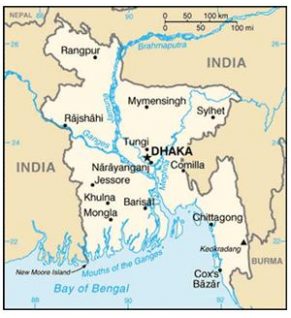GMG Airlines has quickly established itself as the second largest carrier in Bangladesh where it takes a 12% slice of all scheduled seat capacity in Bangladesh according to Flightbase (14-20 June 2010). State-run national carrier Biman Bangladesh leads the way on the basis of seat capacity.
Summary of the five leading carriers in Bangladesh:
|
Carrier |
Weekly Seats |
Destinations |
Market Share |
|
Biman Bangladesh |
21,380 |
18 |
25% |
|
GMG Airlines |
10,600 |
12 |
12% |
|
United Airways |
5,957 |
7 |
7% |
|
Emirates |
5,055 |
1 |
6% |
|
Saudi Arabian Airlines |
3,930 |
3 |
4% |
|
Total |
85,477 |
46% |
From GMG's main base, it flies to 10 points using a mix of MD80/82 aircraft. Domestic sectors are fed using smaller regional aircraft, while a medium-range B767-300ER aircraft is deployed on its Dhaka - Dubai routing - its first service to the Middle East.
Abu Dhabi follows and makes up the airline's eighth international destination, complementing its Dubai schedule (both are twice-weekly) and also serves as an extension to its existing four-times weekly flights to Karachi, Pakistan. The route will compete with Biman Bangladesh's once weekly operation and Etihad's daily service (both are non-stops), and there is also competition on all of the routes in its international network.
Its remaining seven international routes on the route map are highlighted:
|
Destination |
Originating Airports Frequencies (weekly) |
Total frequencies (weekly) |
|
|
Chittagong (CGP) |
Dhaka (DAC) |
||
|
Kolkata (CCU) |
4 |
14 |
18 |
|
Tribhuvan (KTM) |
7 |
7 |
|
|
Kuala Lumpur (KUL) |
7 |
7 |
|
|
Karachi (KHI) |
4 |
4 |
|
|
Bangkok (BKK) |
3 |
3 |
|
|
Delhi (DEL) |
3 |
3 |
|
|
Dubai (DXB) |
2 |
2 |
|
|
Grand Total |
4 |
40 |
44 |
Source: Flightbase, June 14-20, 2010
As the table (above) shows, all but four of its international flights are served from Dhakar. These four frequencies link Chittagong with Calcutta.
While its international markets are weighted in Asia, the Abu Dhabi service dovetails nicely into its international route strategy.
Last year, Beximco Group bought a 50% stake in the (private) GMG Group-owned airline, which has been trying to build its brand through a marketing campaign, highlighted by its recent sponsorship of the England-Bangladesh cricket series. The sponsorship deal shows an ambition to be an internationally recognised carrier as it tries to pursue a larger network.
What's the Significance of Abu Dhabi?
Abu Dhabi has maintained its strong economic growth and the construction sector has created jobs for the Bangladeshi migrants, which in turn has created demand for additional airlift. The stop in Karachi is for technical reasons, although over 140,000 O&D passengers flew between these city pairs between January 2009 and 2010, according to IATA BSP data (Airport IS). The low frequency schedule on offer therefore carries low risks for the carrier.
IATA BSP data shows that over 133,000 O&D passengers flew between Dhaka and Abu Dhabi in the same period, with Etihad taking a 29% market share. The market has grown steadily since 2008, carrying 60,582 O&D passengers in 2008 and 88,618 passengers in 2009.
Abu Dhabi-Dhaka flights have become increasingly popular with business, VFR, student and ethnic traffic, as the airline's chief commercial officer, Ajith Weerasekera explained during the official route announcement last week. "We are already assessing the opportunity to scale up capacity by deploying the larger B767-300ER on this route," he said.
European Expansion - New Challenges
There could be opportunities for GMG to expand to Europe, however at the moment, the O&D market is relatively small, with 346,226 passengers flying between Bangladesh and Europe (from January 09-10), compared with over 2.3 million people travelling between Bangladesh and the Middle East in the same time period (as IATA BSP data shows).
Plus, operating to Europe will give rise to new challenges. For example, GMG would require its own agents in order to break into the ethnic passenger market - something that is effectively sold through Biman, Emirates and Qatar Airways. Several additional aircraft would also be needed to secure a reasonable schedule and the market has options that are competitive.
On balance, the cost of entry into any of the European markets would be high for GMG compared with the Gulf where GMG just has to identify the labour agencies and recruiters to secure large volumes of Bangladeshi traffic. For now, extending the network to other Gulf States becomes relatively easy and cheap for GMG rather than having to undertake major consumer marketing in completely new markets.

Bangladesh is bordered by India to the east, west and north and by the Bay of Bengal to the south. Its population is estimated at 155 million, according to the World Health Organisation.





